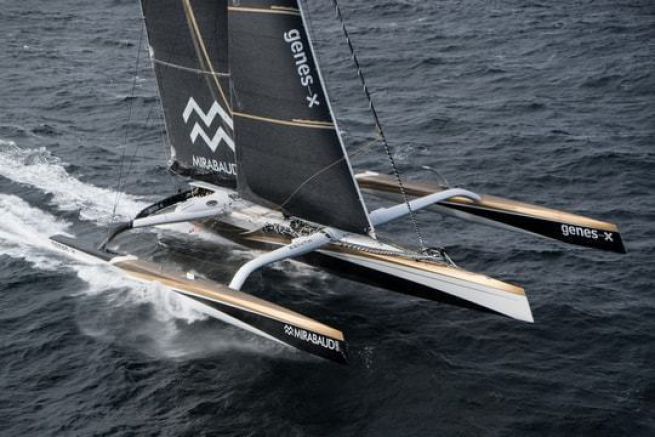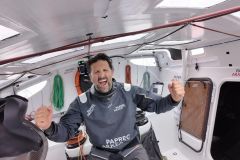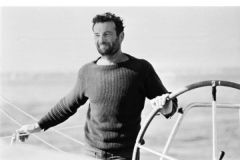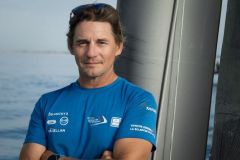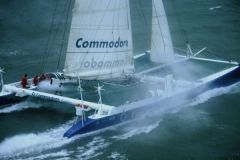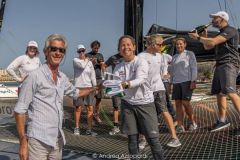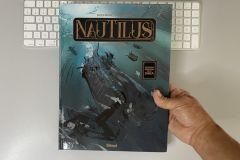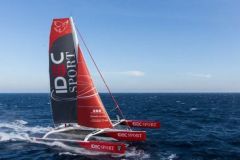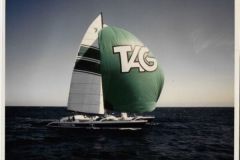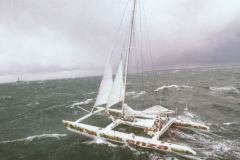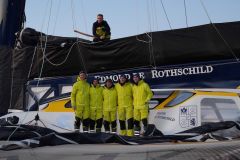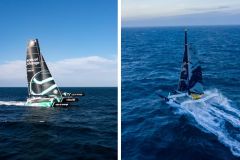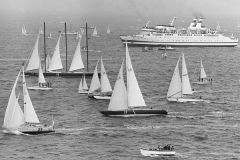In November 2013, the sailors of Spindrift Racing improved the record of the Discovery Route (Cadiz - San Salvador) by 20 hours with a crossing of the Atlantic in 6 days, 14 hours, at a speed of 24.50 knots.
The year 2014 has a twofold objective: to tackle the North Atlantic crewed record (New York-Cap Lizard) during the summer and to start the Route du Rhum in the autumn in the Ultimate category.

A lot of work on the site to adapt the trimaran to solo sailing
To do this, the trimaran enters the yard for 4 months in Lorient, in order to be adapted to solo sailing. In all, 20 people will be involved in the transformation of the boat.
"This year, we're doing crew and solo. We have made choices to perform well on both fields. It also allows us to explore avenues of innovation for the Jules Verne Trophy, the flagship objective of our campaign with Spindrift 2.
A 6 m shorter mast for the solo
The main modification concerns the mast, which has been shortened by six metres to make the boat more manoeuvrable on its own. With 20% less sail area, Spindrift 2 will also be lighter this season while remaining efficient. It also involves changing the way the mast is attached to the boat. Some chainplates are removed and a new one is created, that of the staysail forestay, a very structural part that holds the mast" explains Antoine Carraz, technical and sailing manager of Spindrift racing in 2014.
Indeed, there are three of them, these chainplates are carbon parts attached to the deck that fix the cables that carry the sails, in other words, these parts attach the boat's motor (mast/sails) to the chassis (platform). " The main chainplate supports a working force of 35 tons ", specifies this mechanical and structural engineer, "Currently, we have two people working for only three months on this complex area of the boat."

Fewer sails
By reducing the rigging, the Spindrift racing team not only gains weight in the tops, but also reduces the sail clearance. "Lightness is the lifeblood of multihull warfare," he continues. "Removing the large gennaker, which is not manoeuvring solo and too big for the wind force required on the North Atlantic, saves us 200 kilos. The same goes for Solent, where 300 kilos are still being saved. We have also removed the mast tilt. This system allows the rigging to be angled from one side to the other when the trimaran heels. Solo, you sail with the central hull in the water. It is therefore a heavy equipment with a very low performance gain in solo sailing. For the North Atlantic, which is done on a single crewed tack, we have the possibility of tipping the mast at the start in a fixed way. So we decided to remove the cylinders and the hydraulic power unit, a further gain of 400 kilos."
Simplified appendices
No major change on the rudders and foils, which remain identical, only the daggerboard will be new. "When the boat was designed and with the idea of racing around the world, the original daggerboard had a trimmer (rear flap like on an airplane wing that allows you to sail upwind better). In the Atlantic as well as on the Jules Verne, our routes will be mainly downwind where we sail with a high drift. We will therefore have a new part without trimmer, 200 kilos lighter, optimized in structure and shape for sliding."
A bike to work with your legs
Despite the pharaonic measurements of Spindrift 2, Yann Guichard has two arms and two legs to control him alone. Border several hundred square metres of mainsail, take/release one reef, unroll/roll a headsail, painful minutes even for six grinders who mill on the three columns of the cockpit in crew version. For the Route du Rhum, Yann keeps two mills, one on each side, and also adds a bicycle to use the force of the lower body as Franck Cammas did when he won in 2010.

Nevertheless, a glance is enough to realize that at the helm, it is difficult for Yann Guichard to keep control of the sheets on his sails. Automatic pilots are therefore the cornerstone of this solo transatlantic race. The solution found by Spindrift racing is ingenious as Antoine explains. "The boat is too big to use hydraulic cylinders. As it is very large, it is also very stable so there are few bar corrections to give. As a result, we use recreational boat pilot engines with a system invented by the team. We already tested the device on the Miami return conveyor last year and it works very well."
Finally, the trimaran's dimensions once again dictate their laws to the skipper who, for safety reasons and performance concerns, will remain on constant watch on deck. " We set up Yann's life cell outside, sheltered under the cap. He will have his computer screens, his pilot controls, all the tips at hand if necessary and his bunk to rest as soon as he can."
Pounds gained everywhere
Finally, dozens of details that are not on these boats contribute to this virtuous circle of maximum load shedding. Some kilos had already been gained last year on the spectra nets, the bunks and kitchen will be dismantled before the Rum and a new lighter chart table is also in production. "We reflect on each part that has been dismantled to gain the slightest gram. We weigh everything at the reassembly to take stock. In total, if we can save two tons, it's 10% of the boat's weight, which is huge."
In June, Spindrift 2 enters standby at Newport waiting for a favourable weather slot to set off for the Atlantic, but no windows open during the summer. The trimaran is returning to France. In November 2014, Yann Guichard took part in the Route du Rhum and won the 2 eST PRIS DANS LE GROS TEMPS, ET TANGUE DE GAUCHE ?ROITE, SECOUÉ PAR LES VAGUES. UN HOMME, SANS DOUTE UN PÊCHEUR QUI PARTICIPE À UNE SESSION DE PÊCHE SPORTIVE, PASSE PAR-DESSUS BORD, DE MANIÈRE ASSEZ IMPRESSIONNANTE. place.
Switch back to crew mode for the Jules Verne Trophy
Then when she returns from the race, the trimaran enters the yard again to return to crew mode. The project will be carried out at Multiplast, in Vannes, during the winter of 2014.
The major optimisation concerns the 42 m mast, specially designed by the Spindrift racing design team and GSea Design for the Jules Verne Trophy and built at CDK in Port-la-Forêt. It will have taken a year and a half of design and construction. The project led by Spindrift racing has saved 1 half-tonne, or a quarter of the total weight of the original spar. The mast, which tilts sideways for more power, is placed on a ball joint that can support 80 tons of load.

Benches, kitchen, chart table, storage space: the interior equipment has been lightened, without making any concessions on the minimum comfort necessary to live with 14 sailors in 20m2.
The Spindrift 2 manoeuvring area has been partially redesigned with a simplified deck layout and an extended cap for aerodynamic gain and better protection from spray in heavy seas.
Downwind, Spindrift 2 can carry 1230 m2 of sails: mainsail, gennaker and staysail.
See the details of the work done on Spindrift 2
